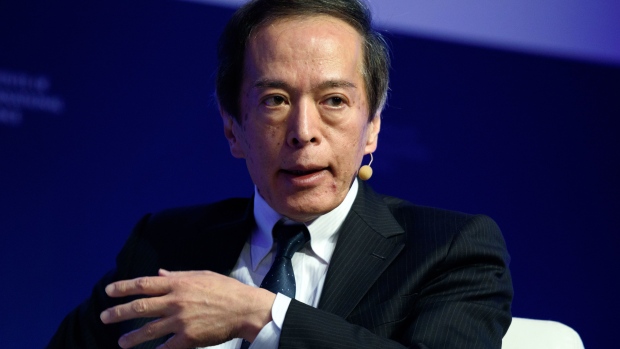Feb 10, 2023
‘Japan’s Ben Bernanke’ Shows MIT’s Sway, With Ueda Eyed for BOJ
, Bloomberg News

(Bloomberg) -- Stanley Fischer’s school of central bank leadership has a new graduate.
Before he served as vice chair of the Federal Reserve and as Israel’s central bank governor, Fischer, 79, taught economics at the Massachusetts Institute of Technology, where he had earned his own Ph.D.
Among his students were Ben S. Bernanke, who would go on to become Fed chair, and Mario Draghi, a future European Central Bank president. Former Treasury Secretary Lawrence Summers also studied under him. Reserve Bank of Australia Governor Philip Lowe earned his Ph.D. at MIT when Fischer was there, and Lowe’s former deputy Guy Debelle was the last graduate student Fischer supervised.
Onetime Bank of England governor Mervyn King also taught at MIT, where he had an adjoining office with Bernanke.
Now, another pupil is set to take one of central banking’s top jobs. Kazuo Ueda is expected to be named the next governor of the Bank of Japan.
Ueda completed his Ph.D. at MIT in 1980, before going on to a mainly academic career that also featured a seven-year stint on the BOJ’s board.
“We can think of him as being Japan’s Ben Bernanke,” Summers told Bloomberg Television’s “Wall Street Week” with David Westin Friday. “He studied at MIT at about the same time that Ben did, with the same thesis advisor that Ben Bernanke had. He specialized in similar areas of monetary economics, and has a soft spoken academic way about him, but is also capable of being decisive.”
A former economics lecturer at the University of Tokyo — where he got his undergraduate degree — Ueda, 71, is now a professor at Kyoritsu Women’s University. He served as a BOJ board member from 1998-2005 when the central bank introduced a zero interest rate policy for the first time and embarked on quantitative easing.
Bernanke, similarly, had a career in academia prior to joining the Fed board and later taking the helm of the central bank.
“He comes with a strong pedigree,” said Ilya Spivak, head of global macro at tastylive, a financial network. “There are a lot of big central bankers that came up under Fischer.”
It’s something of an unusual pedigree for a BOJ chief, who is usually drawn from the ranks of career BOJ or Ministry of Finance bureaucrats.
‘Real World’
Fischer has said the emphasis at MIT was “economics about the real world.”
“The faculty makes the place but the students also make the place,” Fischer said in a 2012 interview. “One of the reasons you go to MIT is because you have the best students in the world.” To him, economics was a tool to “do something useful.”
He later downplayed his own role in the rise of Bernanke and Draghi. That duo slashed interest rates and launched quantitative easing programs in the US and Europe as the world economy was buffeted by the 2008 financial crisis and a debt crisis emerged in the eurozone.
“I’d like to be able to say all the things they are doing were from what they learned in lectures at MIT, but it wouldn’t be true,” Fischer said in a 2013 interview. “From now on when we teach these courses, we’ll teach the lessons we’ve learned from Bernanke and Draghi.”
Fischer had multiple stints at MIT, having joined the school’s faculty as an associate professor in 1973 and becoming an endowed professor in the early 1990s. He is now professor of economics, emeritus.
Like his pupils, Fischer got to experience setting policy not just studying or teaching it. He said he acquired “the policy bug” when he asked in the 1980s to help come up with solutions for Israel’s economic problems. Years later, he served as the No. 2 at the International Monetary Fund, the governor of the Bank of Israel from 2005 to 2013 and as No. 2 at the Fed from 2014 to 2017.
Before those roles, he advised Ueda on his Japanese student’s 1980 dissertation, Dynamic Interactions between Trade Flows and Exchange Rates: Theory and Evidence.
At the time, a swelling Japanese trade surplus was spurring deep political concerns in the US. It was a topic Ueda returned to in a paper later in the 1980s, Perspectives on the Japanese Current Account Surplus, which Fischer edited. Among the commentators on that work: current Federal Reserve President Susan Collins.
If officially nominated by Prime Minister Fumio Kishida as expected on Feb. 14 and approved by parliament to take over at the BOJ in April, Ueda would take the helm at a time of immense challenge. Japan’s inflation rate is at a four-decade high, but any move to abandon the BOJ’s interest-rate targets could destabilize markets.
“Japan has a very complicated issue ahead of it — I don’t think it’s going to be able to maintain yield control for an indefinite horizon,” Summers said. “Mr. Ueda’s skills are going to be tested.”
©2023 Bloomberg L.P.






